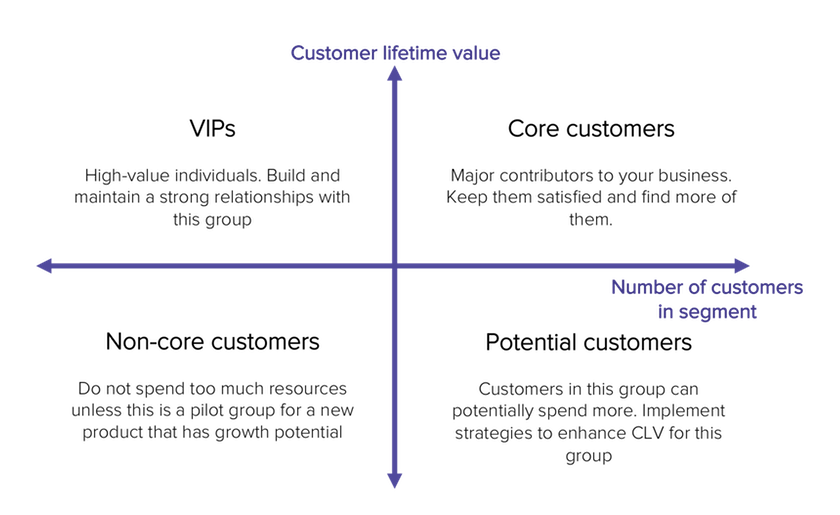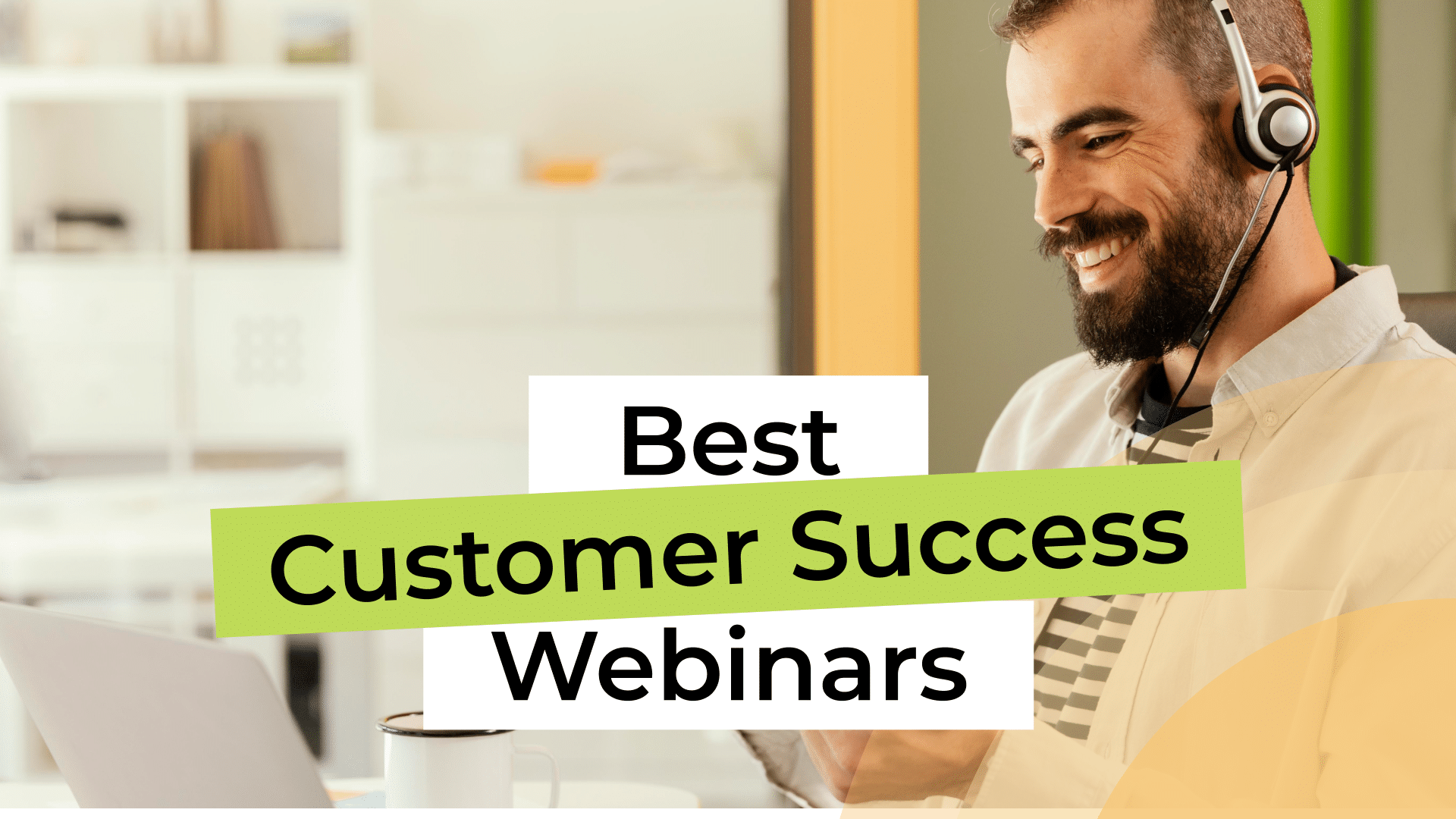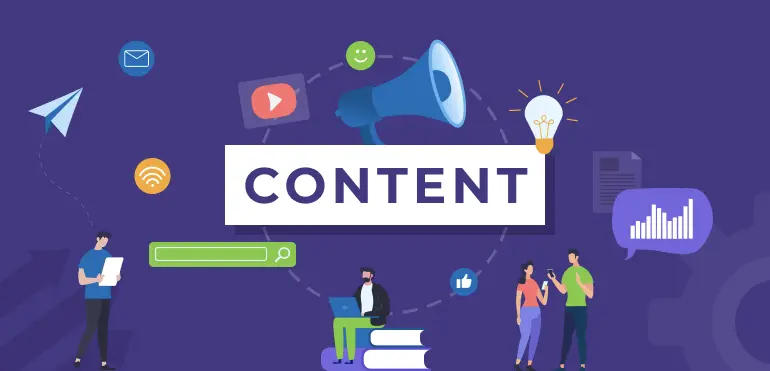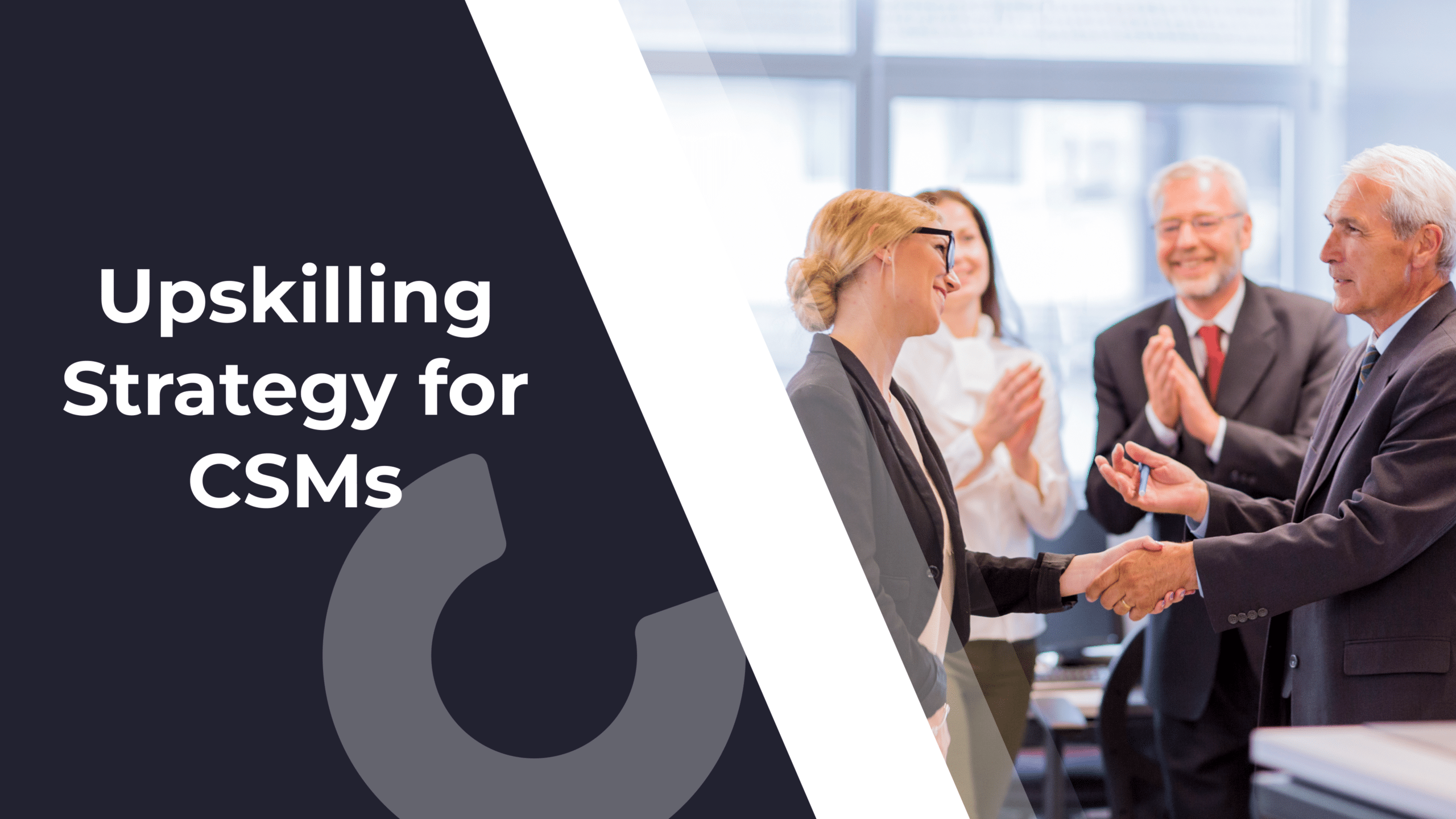Picture this: It’s the holiday season, and you’re faced with the delightful challenge of picking the perfect gifts for your friends. Each of them is unique in his tastes, preferences, and interests. One’s an avid bookworm, another a coffee connoisseur, and another a gym rat.
Because you know them so well, choosing gifts that resonate with their personalities comes naturally. As you hand out your well-thought-out presents, you notice the sparkle of joy in their eyes that lets you know you just knocked Christmas out of the park.
‘But what’s this got to do with customer segmentation in the world of Software as a Service?’ – you ask.
The answer is simple: it’s the perfect analogy to demonstrate the power of customer segmentation. Just like knowing your friends leads to thoughtful gift selections, understanding your SaaS customers on a granular level can revolutionize how you engage, serve, and retain them.
What is user segmentation in SaaS?
To keep a long answer short, segmentation is nothing more than grouping users together based on their needs and behaviors.
Imagine being able to anticipate your audience’s reactions to a campaign way before launching it. Sorcery? Far from it. It’s data science. The users who interact with your platform leave behind a trail of their actions. Every action the user takes is a unique tile. As you begin to gather enough tiles of data, you start seeing the big picture. The grand mosaic you piece together is nothing but your user segment – individuals who’ve shown similar behaviors, interests and preferences.
So far, so good. Now, this is where things start to get interesting. Because when it comes to segmentation examples, you’ll usually find stuff like, ‘This product is meant for people aged 30 to 50.’ And sure, that’s a valid demographic segment. However, a useful segmentation needs to go beyond demographics.
For example, let’s say you’re running a health and fitness app. A segmentation for this type of product could include combinations of things such as the time of day they’re using your product and workout goals. These early birds may have different preferences and motivations compared to the “Night Owls,” who prefer late-night workouts. Combining your users’ behavioral data allows you to craft tailored experiences that speak directly to their wants and needs.
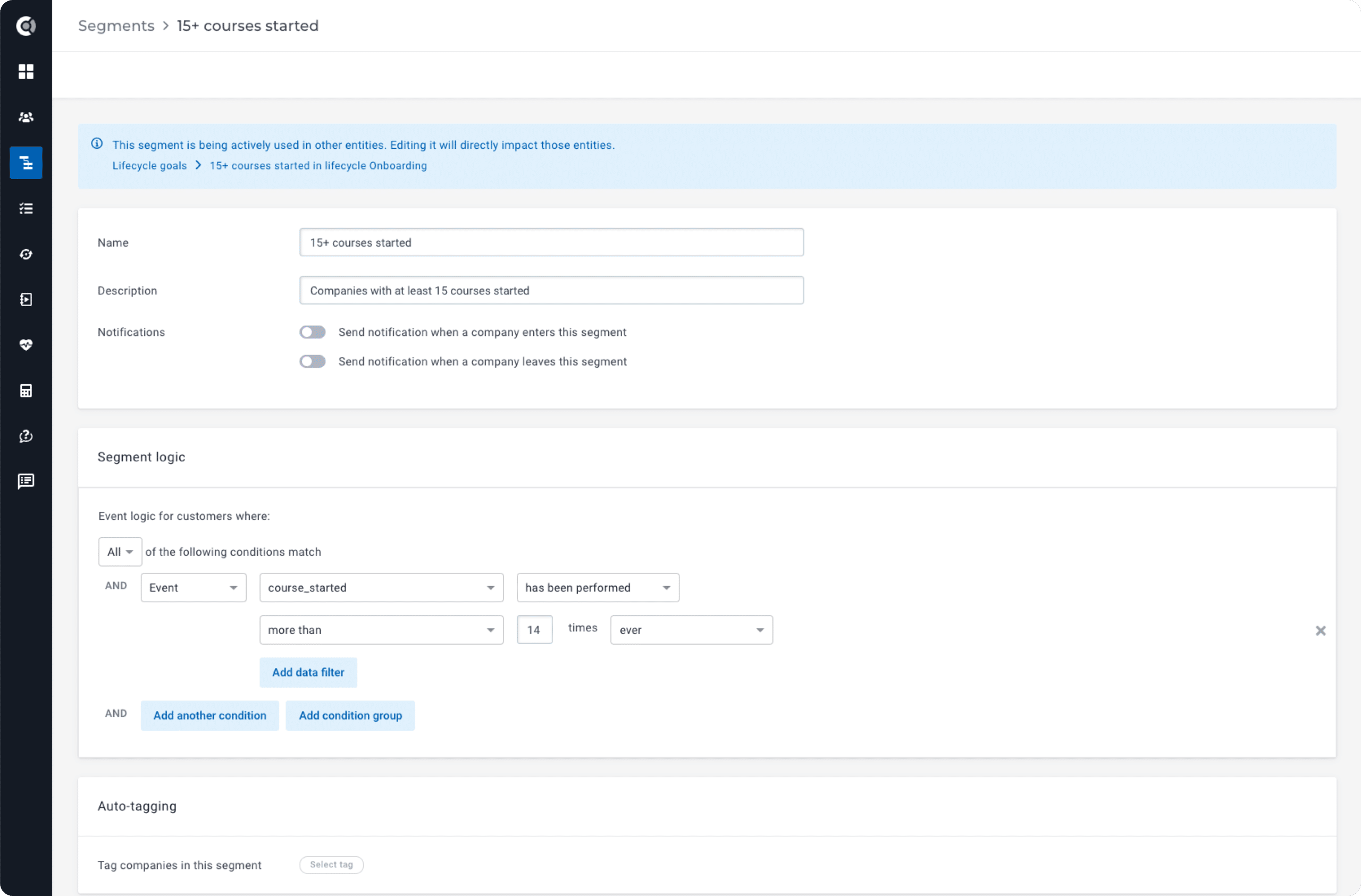
Identifying Your Ideal Customer Profile (ICP) Through Segmentation
In the realm of customer segmentation, one term you’ll often encounter is the Ideal Customer Profile (ICP). It’s crucial to distinguish this from a Buyer Persona, which is a more generalized representation of your customer base. The ICP, on the other hand, is a laser-focused description of the customer who is most valuable to your SaaS business over the long term.
Why ICP Matters for SaaS CSMs in Segmentation
For Customer Success Managers in SaaS, understanding the ICP is vital for several key reasons:
- Churn Reduction: An accurate ICP allows you to identify customers who are more likely to be long-term users of your product, thereby aiding in churn reduction strategies.
- Optimizing Customer Lifetime Value (CLV): The ICP isn’t just a snapshot of who’s likely to buy your product; it’s a roadmap to the kinds of customers who will bring in upsells, cross-sells, and renewals.
- Resource Efficiency: Knowing your ICP enables you to allocate customer success resources more effectively, ensuring a higher ROI on your initiatives.
How to Discover Your ICP Through Segmentation
The key to uncovering your ICP lies in effective customer segmentation. Here’s how:
- Data-Driven Analysis: Use your existing SaaS metrics, such as usage data, feature adoption rates, and customer feedback, to identify trends among your most successful and satisfied customers.
- Multi-Faceted Segmentation: Don’t just rely on basic demographics. Go deeper by segmenting your customer base based on behavioral patterns, engagement levels, and even customer health scores.
Constructing a comprehensive ICP allows you to customize your customer success strategies, from onboarding to retention, to cater specifically to those customers who are most aligned with your product and most likely to contribute to its long-term success.
Customer Segmentation Checklist for SaaS Marketers and CSMs
Before embarking on customer segmentation, a marketer or Customer Success Manager (CSM) should ask themselves several critical questions to ensure that the segmentation strategy aligns with the company’s goals and provides actionable insights. Here are some key questions to consider:
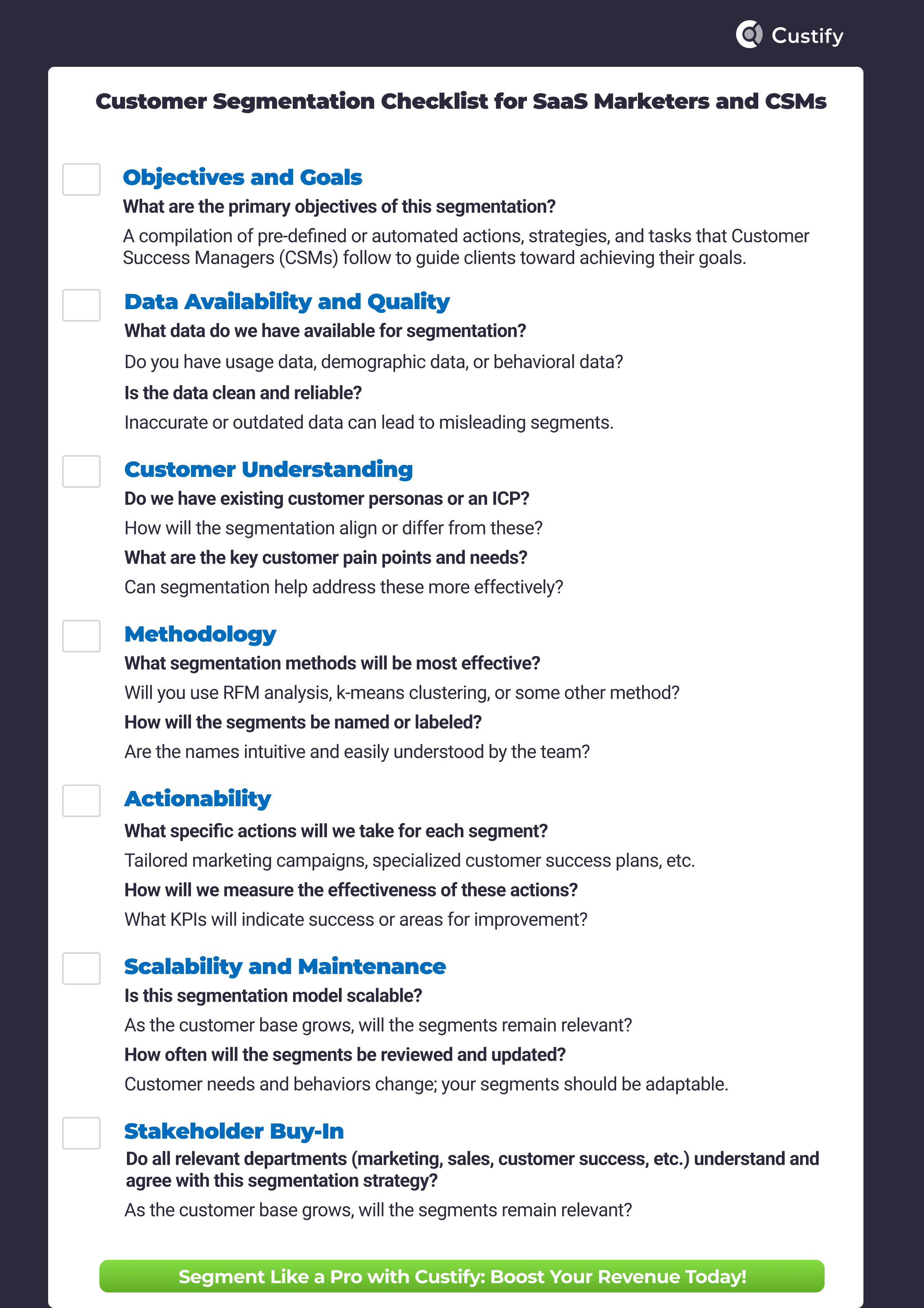
.
Should you segment accounts or individual users?
Aaah, the good-old segmentation dilemma – if you’re using account-level data and both accounts and users can have segments of their own, which one should you use?
Account-level segments provide a bird’s-eye view of how entire accounts move through the intricate landscape of the customer lifecycle. In the B2B SaaS realm, customer lifecycles often revolve around the journey of the entire account. However, don’t overlook the potential for synergy between account-level data and user activity.
Here’s where the magic happens: when you bridge the gap between account-level insights and user-level engagement, you capture the essence of the user lifecycle. Why is this valuable, you ask? Well, consider a user who’s a powerhouse in one account while relatively inactive in another. Instead of treating them as rookies, you can recognize their expertise and group them with power users.
On the other side of the canvas, individual user segmentation delves into the intricate brushwork of personalization.
Take the example of subscription renewals or dunning campaigns. By segmenting users based on roles – say, billing admins – you tailor your messages precisely to their responsibilities. If a user wears multiple hats as a billing admin across different accounts, individual user segmentation ensures they receive relevant communications for each account.
Why customer segmentation is a must
Can you imagine what the world would look like if all clothing stores had the same outfit for all of us? If all the restaurants served the same foods? If there was only one type of music to listen to?
Sounds insane, right? Then why do some SaaS companies treat every user like they’re the same? 80% of consumers are more likely to do business with a brand that personalizes their experience with it. We all want to feel like we’re special. Now, let’s review some benefits you’ll reap once you segment your users.
1. Enhanced personalization and relevance
Like a tailor handcrafting each suit to fit every contour, user segmentation lets you mold your offers according to your users’ styles, quirks, and desires. It’s like making your users feel like they’ve got their own concierge who knows their preferences down to the tiniest detail.
If a tailor chooses his suits’ fabrics to match specific occasions, SaaS uses segmentation to select features and content that speak directly to your users’ aspirations.
As such, every time you present something new, users will find it hard to ignore – because they know you always have their best interests in mind. And remember, according to Adobe, 66% of consumers say encountering content that isn’t personalized would stop them from making a purchase.
Gusto comes with a good example of website personalization. If you land on their website for the first time, you will see the following landing page:

Returning users, however, see a totally different thing.

2. Optimized marketing efforts
According to Evergage, 98% of marketers say personalization advances customer relationships. Now, imagine a thriving e-commerce platform catering to diverse customer needs, from tech enthusiasts to home decor aficionados. The product team faces a tough decision: should they enhance tech-related features or invest in an immersive home decor shopping experience?
Here’s the twist: data shows that the vocally active ‘Tech Enthusiasts’ represent only a fraction of revenue, while the quieter ‘Home Decor Lovers’ contribute significantly.
As a result, the product team prioritizes the latter, doubling down on refining the home decor shipping experience. They enhance recommendations and incorporate interactive tools for room design. While they don’t ignore tech-related requests, they focus on the needs of their most valuable segment.
This strategic shift results in heightened user engagement and conversion rates among ‘Home Decor Lovers. The platform then becomes the go-to destination for home decor enthusiasts, securing its position in this market.
3. Efficient resource allocation
Think about allocating resources like cooking a fancy meal. You may have all the ingredients necessary, but using them randomly will only mean that you’ll end up with something that nobody wants to eat. Just like a skilled chef knows how to combine the ingredients to create the perfect dish, your SaaS needs careful consideration and a strategic mindset to achieve something amazing.
And customer segmentation is one of the paths that will lead you to this promised land. When done right, customer segmentation ensures you’re not just throwing ingredients into a pot, but you’re creating a gourmet experience.

Knowing your customers inside and out is the cornerstone of business success. Imagine the game-changing power of discovering that most of your users are hooked on a specific feature or service you offer. That’s not just a clue; it’s a roadmap pointing you exactly where to channel your energy and resources.
Data Point: Instapage reports that 88% of U.S. marketers have seen a measurable uptick in performance thanks to personalization. So, you’re not just throwing darts in the dark; armed with customer segmentation, you’re hitting the bullseye every time.
By focusing on what truly resonates with your audience, you’re not just making educated guesses—you’re orchestrating a symphony of customer satisfaction and business growth.
4. Strategic decision-making
Calling the right shots at the right time can make or break a business. Do you know who was a great decision-maker? Steve Jobs. He wasn’t just a tech wizard. He was perhaps one of the best decision-makers in business history. He was the one who crafted Apple’s product lineup and streamlined its offerings to a few key products.
While he was a visionary like none other, Steve Jobs didn’t have a crystal ball that predicted the future. Far from it – his decision resulted from strategic thinking and an understanding of the market dynamics of that time. He simply understood user preferences and needs. And that’s exactly what customer segmentation allows you to do.
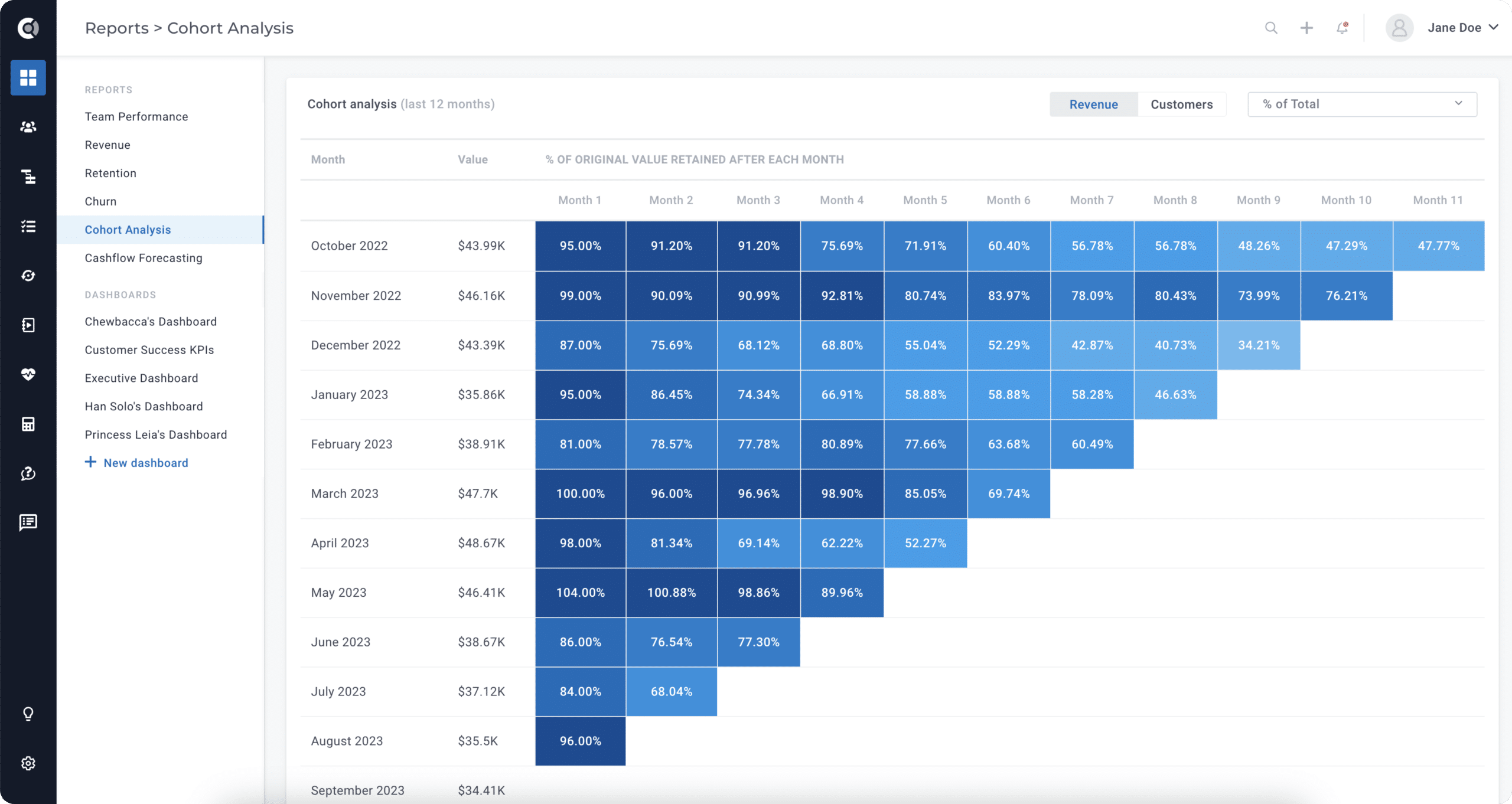
Think of customer segmentation as your data-driven compass, guiding you through the maze of consumer preferences, behaviors, and expectations. It’s not just about collecting data; it’s about interpreting it in a way that lets you virtually walk in your customers’ shoes. What could be more insightful than that?
By leveraging customer segmentation, you’re not just making decisions; you’re making informed, strategic choices that resonate with your target audience. In doing so, you’re not just running a business—you’re steering a transformative journey that could set new industry standards.
5. Increased customer satisfaction and loyalty
Your customers don’t care about you, about the numerous awards you’ve won, and generally, anything that doesn’t have to do with their interests. So don’t trouble them with offers or products that don’t fit their needs. That is, if you care about your users’ happiness.
And you should care. Because the success of your SaaS is directly proportionate to your customer’s satisfaction and loyalty. And customer segmentation is the compass that will guide your company toward this destination. Segmenting allows you to personalize every interaction you have with your users. Unless you understand your main user segment’s preferences, pain points, and usage patterns, tailoring your communication, recommendations, and support to each one of them is nothing but a distant dream.
However, once you’ve ticked all those boxes, the level of personalization you’ll achieve will not only enhance your customer’s experience but will indirectly serve as testimony to your willingness to meet their unique needs, thus improving customer lifetime value.
According to Salesforce, 70% of consumers say a company’s understanding of their personal needs influences their loyalty. So, customers who feel valued and understood are more likely to foster a deeper connection with your brand. That’s how long-term relationships are built.
SaaS companies that build user relationships based on relevance and resonance are the ones that will make it through the test of time while others fail.
By consistently delivering solutions that align with individual needs and aspirations, these SaaS companies establish themselves as indispensable partners in their customer’s journey. While feeling trends come and go, relationships rooted in understanding and empathy are the bedrock of long-lasting success.
6. Identify emerging trends & new opportunities
In essence, the relationship between customer segmentation and trend identification is symbiotic. Just as a seasoned tracker follows footprints to anticipate an animal’s path, segmentation guides SaaS companies toward anticipating the path of evolving customer preferences and industry shifts.
You’re looking for sudden changes in how your segments react to your offers and communication. As soon as you notice a shift, start studying the segments that exhibit these evolving behaviors or new preferences. By doing so, you’ll be able to seize opportunities before they hit the mainstream, offering you a competitive edge.
And there’s more: customer segmentation also unveils pockets of revenue potential that would remain untapped otherwise. Your SaaS can spot untapped niches and burgeoning markets by looking at segments that express a heightened interest in certain features or solutions. This opens the door to innovation and expansion.

The main types of customer segmentation strategies
Alright – it’s now time to dive into customer segmentation strategies. Just as a skilled construction engineer selects different materials to build a sturdy building, SaaS companies employ various segmentation approaches to construct a comprehensive understanding of their customer base.
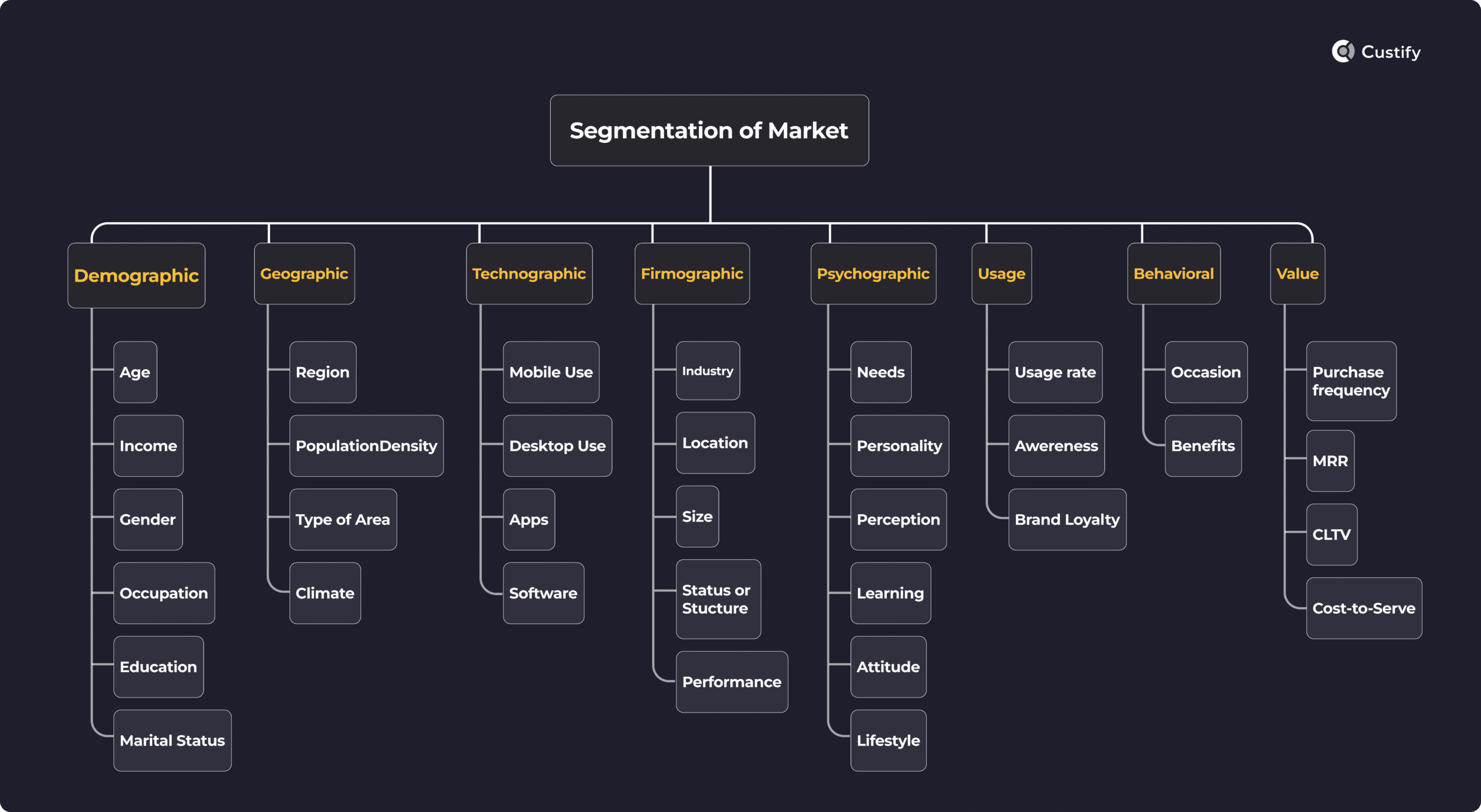
1. Demographic (who)
We’ll start with, perhaps, the most common segmentation strategy of all: the one based on demographics. “Men between 18 and 30” would be an example of demographic customer segmentation.
Demographic factors include but are not limited to occupation, marital status, income, education, etc.

Advantages
Demographic segmentation offers businesses a straightforward and cost-effective method to categorize customers based on fundamental characteristics like age, gender, income, and marital status. This simplifies target audience identification and enables personalized marketing campaigns that resonate with specific segments, enhancing marketing effectiveness.
Limitations
Demographic segmentation has its limitations. It can oversimplify customer behaviors and preferences, as individuals in the same demographic category may differ significantly. Moreover, demographic data can change over time, necessitating ongoing adjustments to segmentation strategies to remain relevant and effective.
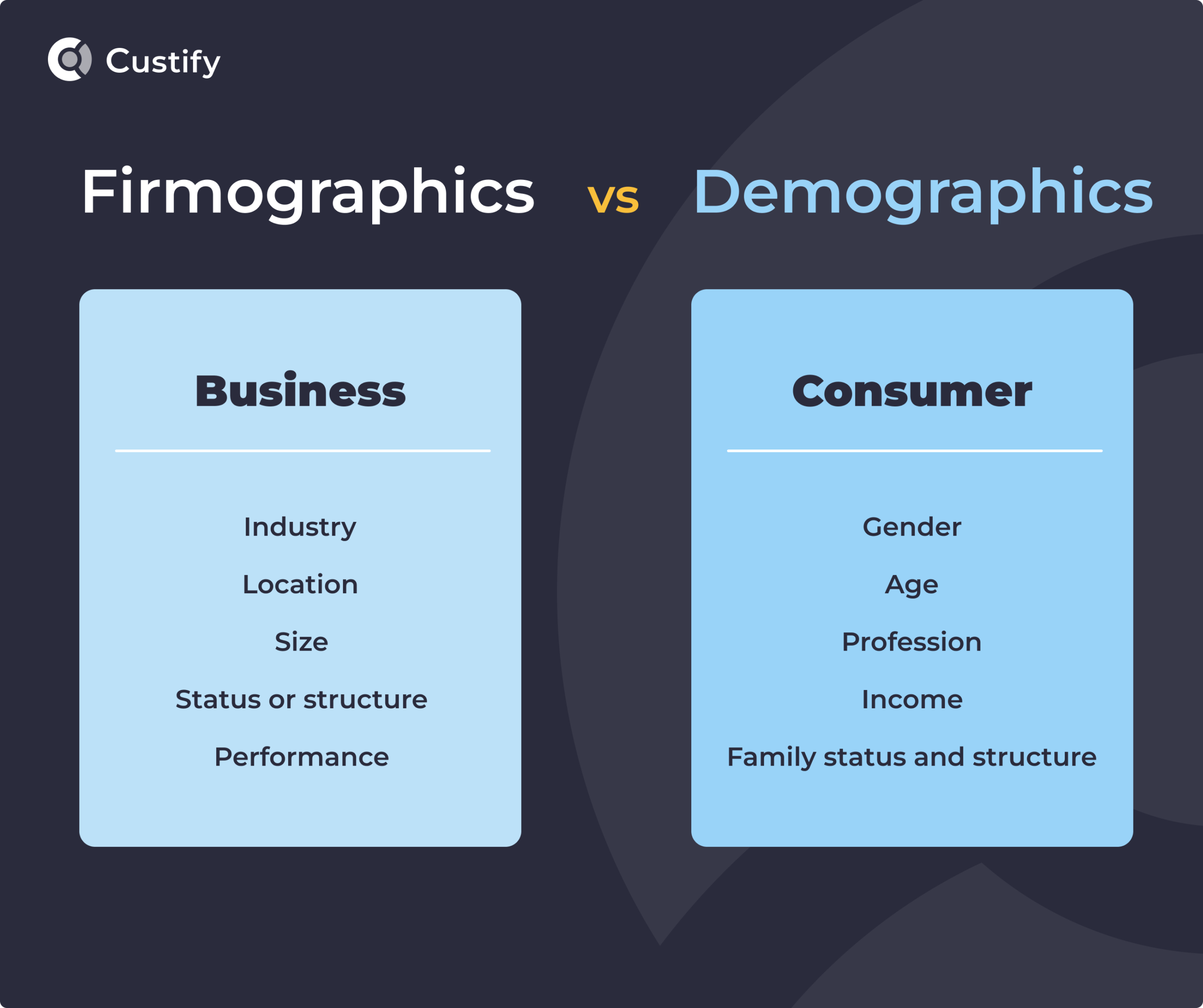
2. Firmographic
If B2C businesses rely on demographics to group together users by their traits and characteristics, B2B business resorts to firmographics.
Firmographic factors include industry, number of employees, legal status, financial standing, revenue, growth rate, etc.
By highlighting organizational similarities that connect to the customer experience, SaaS companies can structure their marketing strategies to a more significant effect and more accuracy.
Advantages
Firmographic segmentation is advantageous for B2B companies as it focuses on business-related data such as industry, company size, revenue, and location. This type of segmentation helps tailor products and services to the unique needs of different businesses, making it easier to target high-value clients and enhance customer satisfaction.
Limitations
On the flip side, firmographic segmentation may not account for individual users within a business, potentially missing the nuances of specific user needs or behaviors. Additionally, firmographic data can change due to business mergers, expansions, or downsizing, making it essential for companies to update their segmentation strategies regularly.
3. Technographic
As the name suggests, this segmentation strategy refers to grouping your customers based on a technology or group of technologies.
Creating technographic segments requires collecting data about your customers’ technology, products, or services.
For example, Android users may be a technographic user segment.
Let’s take a look at the example below. As we can see in our Google Analytics domain, most users come from Android devices.

So, what can we do with this type of information? Well, we could, for starters, make sure that our app is optimized first and foremost for that platform,
Advantages
This segmentation strategy offers valuable insights into your customers’ technologies and tools and allows you to align your product offerings with their preferences. The result could be more effective marketing campaigns and product development, helping you stay competitive in a tech-driven market. Another bonus of technographic segmentation is that it lets you identify early technology adopters, a potentially influential segment.
Limitations
However, just like demographic or firmographic segmentation, this type of segmentation may only capture part of the scope of a customer’s needs and preferences, as it primarily focuses on technology-related data. Additionally, technology usage can change rapidly, so maintaining accurate technographic data is essential for effective segmentation. Overreliance on technographic data alone may overlook other critical factors influencing customer behavior.
4. Geographic (where)
Geographic segmentation is pretty much what you’d expect it to be – grouping users together based on where they find themselves – from country down to postal code.
The idea behind this type of segmentation is that people from a certain region may find particular use cases for your product that don’t apply to other segments.
Think about the clothes in your wardrobe. If you live in a tropical country, chances are you don’t have that many winter coats or thick sweaters taking up space. And, if you live in a place where it snows, you may not be the person to have an extensive collection of swimsuits.
Just as your wardrobe adapts to the climate you’re in, geographic segmentation allows your product offerings to adapt to the diverse climates and needs of your customers across different regions. It’s like tailoring your marketing strategy to fit each customer’s specific “fashion” – delivering what’s stylish and functional for their location.
In the example below, you can see that most users come from the UK. As a result, creating a UK-only segment would make sense for that business.

Advantages
Geographic segmentation provides insights into customer preferences and needs based on their geographical location. This allows businesses to tailor their marketing efforts to specific regions, ensuring relevance and cultural appropriateness.
Limitations
On the other hand, geographic segmentation oversimplifies customer behavior. People within the same geographic area can have diverse preferences and needs. Additionally, focusing solely on geographic factors may overlook other critical psychographic or behavioral characteristics that influence buying decisions.
5. Psychographic (what users are like)
Alright, this is where things start getting interesting.
Psychographic segmentation is getting to know your customers on a deep, personal level. We’re talking about knowing them like you know your special someone. This includes their personality, the lifestyle they live, their values and beliefs, what makes them tick, and pretty much everything about what they’re like and why they’re like this.

By delving into their personalities, values, and lifestyles, you’re gaining insights that go beyond the surface. It’s like being privy to their secret playlist of preferences, guiding you to craft interactions that truly resonate. And just as a sommelier pairs the perfect wine with a meal, psychographic segmentation helps you pair the right emotions with your SaaS offerings, making them virtually irresistible.
With this window into your customer’s thoughts and motivations, you’re not just selling a product; you’re creating an experience. One that aligns with their core desires. Whether they seek efficiency, innovation, or empowerment, psychographic segmentation allows you to tailor your approach to meet their emotional needs. Because, at the end of the day, the buying process is a dance of emotions. When you’re focused on orchestrating these emotions harmoniously, building long-lasting relationships that go beyond transactions will come naturally.
For instance, the infamous political consultancy firm Cambridge Analytica developed a psychographic model that categorized individuals into specific market segments based on the presence or lack of five key personality characteristics: Openness, Conscientiousness, Extraversion, Agreeableness, and Neuroticism, commonly referred to as the OCEAN framework.

Source: cbinsights
Armed with such data, companies have the ability to fine-tune their messaging and tone to better align with their target audience. The aforementioned company’s achievements with this tactic is well know.
It’s common for marketing experts to blend both demographic and psychographic details to achieve a well-rounded profile of a consumer. This fusion of data allows them to craft more individualized messages, thereby amplifying the potential for meaningful engagement.
For instance, consider the marketing strategy for an eco-friendly electric car. A simple approach might involve targeting environmentally-conscious consumers through social media ads. However, by diving deeper, you could segment your audience into those who are passionate about reducing their carbon footprint and those who are motivated by the long-term cost savings of electric vehicles. This nuanced approach allows for more targeted and impactful messaging.
Advantages
Psychographic segmentation delves deep into the psychology of customers, unveiling motivations, desires, and lifestyles. This valuable insight enables businesses to craft highly personalized marketing efforts that resonate profoundly with their audience, driving engagement and conversions. It also fuels innovative product development, fosters robust loyalty, and empowers content creation that connects with customers’ emotions and desires.
Limitations
While psychographic segmentation offers profound insights, it’s not without challenges. Gathering psychographic data can be resource-intensive, often requiring complex surveys or social media analysis. Oversimplification of customer behavior and preferences is a risk, potentially leading to marketing misfires. Additionally, privacy considerations and evolving traits make it a nuanced approach requiring careful navigation.
6. Behavioral (what users do)
As the name suggests, behavioral segmentation filters and groups your users based on their shared behavioral patterns. An intriguing statistic from Accenture reveals that an astounding 83% of consumers are eager to share their data in order to cultivate a highly tailored and personalized experience.

The behaviors you want to uncover are your users’ actions – browsing pages, signing up for product presentations, or upgrading to superior products. Behavioral segmentation tackles everything about how your users interact with your SaaS, offering insights into what they like, what they avoid, and everything in between.
Each click, every scroll, and every button pressed leaves a digital footprint – like breadcrumbs revealing the path to hidden treasures. When thoughtfully connected, these breadcrumbs reveal a story that speaks volumes about your customer’s preferences and intentions.
The beauty lies in the data you gather. It equips you with the knowledge to not just react to past actions but to anticipate future ones.
It allows you to meet customer needs and expectations with tailored products, services, and promotions. It lets you put together dedicated campaigns to strengthen your customer base. And if optimizing every step in your customer’s buying journey is one of your business goals – which it absolutely should be – behavioral segmentation is a major milestone in your direction.
Streaming giant Netflix offers us a glimpse of how to leverage the power of personalized recommendations based on customer behavior.

Netflix knows this drives engagement, which increases the time users spend on Netflix, which in turn is a great indicator that that user will stay with the company for a long time.
Netflix understands that this keeps viewers interested, leading to more time spent enjoying Netflix content. This, in turn, is a good sign that the user will continue their subscription for an extended period.
Advantages
Behavioral segmentation is about tangible, data-driven insights into how customers interact with products or services. This offers businesses a roadmap for tailored marketing, messaging, and product enhancements. By understanding what specific actions or patterns trigger user engagement, upselling opportunities become more apparent. Behavioral segmentation also aids in identifying loyal customers, enabling companies to prioritize retention efforts and build long-lasting relationships.
Limitations
Despite its strengths, behavioral segmentation has its flaws. It may not fully uncover the ‘why’ behind user actions, lacking insights into motivations and emotions. Overreliance on behavioral data alone can lead to missed opportunities to understand customers holistically. Customers’ behaviors can also change, making segments less stable over time. Privacy concerns and the potential for misinterpreting behavioral patterns underscore the importance of responsibly handling this data.
7. By customer lifecycle stages
Back in the days of the pre-subscription economy, a successful customer journey would mean a closed deal and a new, ideally happy, customer. Fast forward to today, and it’s only after the sale that the real journey begins.
In the grand symphony of user engagement, everyone marches to his beat. As they progress through various product interaction stages, their needs change. Their sophistication level rises. Their expectations are different. As a result, the way you once communicated with them will no longer work.
This is where lifecycle stage segmentation steps in. As users move through their journey, this strategy allows you to fine-tune your communication to match their changing circumstances.
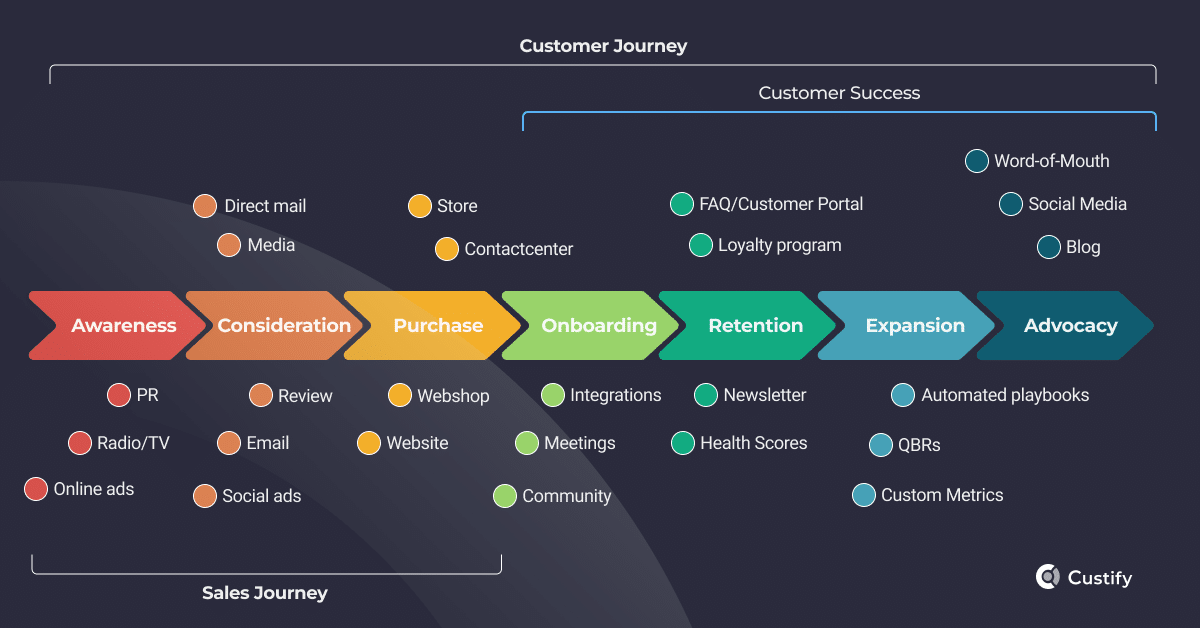
Let’s take a user who’s just signed up. This puts him in the onboarding stage of the subscriber lifecycle. This is where you start grooming him for that long-term relationship you yearn for. He’ll need a guiding hand to help him familiarize himself with your product, so you’ll need to assemble tools and interactive walkthroughs that show your key features one by one.
Fun fact: according to Salesforce, 88% of marketers say their biggest driver in personalization is to deliver a better customer experience.
As the onboarding stage finishes, the engagement phase begins. Imagine a scenario where a streaming platform customer belongs to a specific audience segment – let’s say, history enthusiasts. With this knowledge, you can automate notifications or prominently feature historical documentaries based on their historical viewing patterns and predictive analytics. Each time this customer interacts with your platform, it should feel like a personalized journey, reflecting their interests and engagement history.
When changing how you communicate with customers from various lifecycles, you must also consider nurturing their growth. Just as a fitness coach adapts their training regimen to an athlete’s progress, lifecycle stage segmentation empowers you to nurture users in ways that facilitate continuous improvement. It’s like providing a tailored training program that matches the individual’s skill level and aspirations.
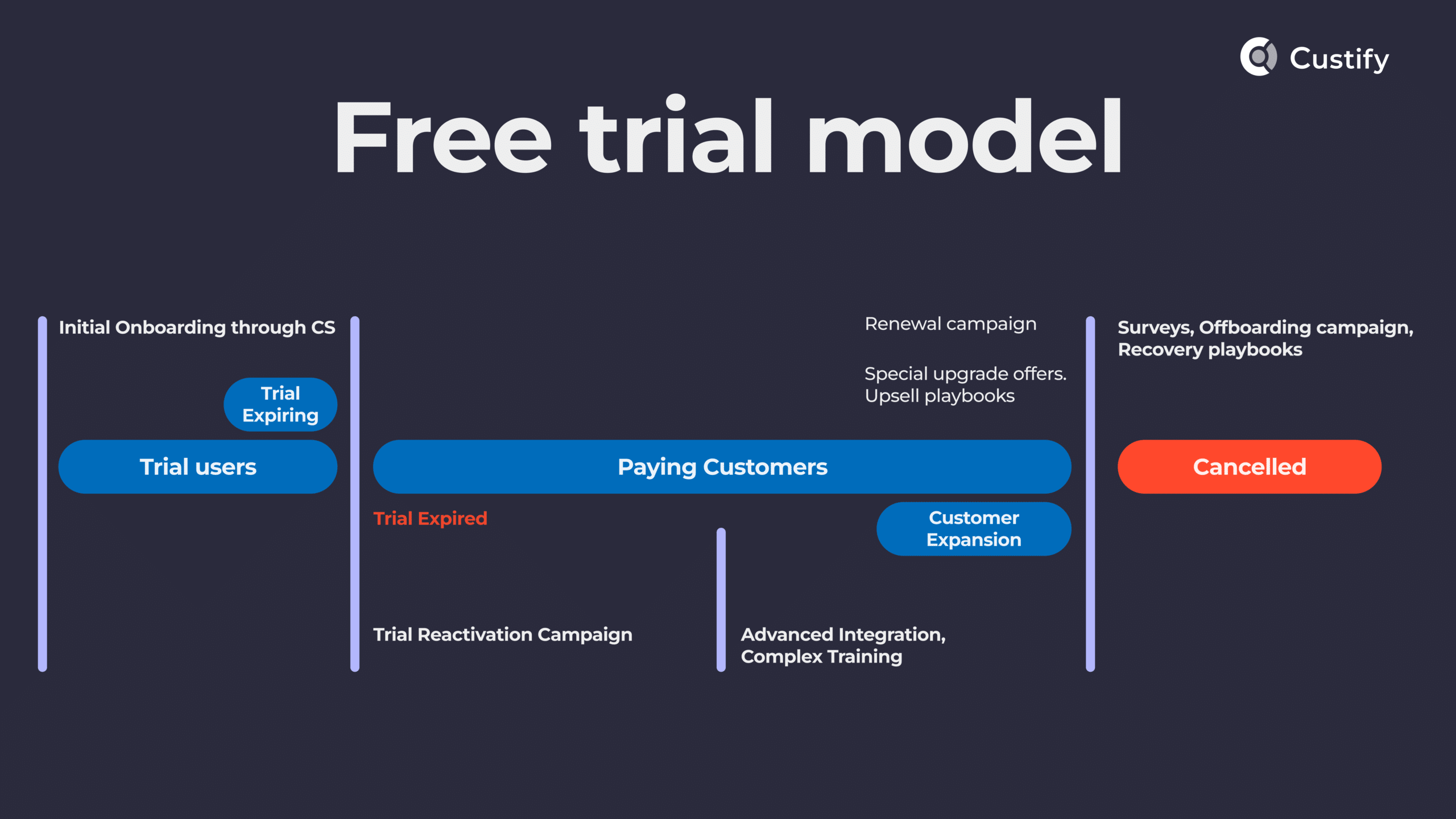
Advantages
Customer lifecycle stage segmentation offers businesses a strategic framework for tailored interactions at each customer journey stage. This approach enables SaaS businesses to provide highly relevant content and support, increasing the chances of conversion, retention, and advocacy. By aligning communication with where customers are in their journey, businesses can foster deeper relationships and maximize customer lifetime value. It also helps allocate resources efficiently, targeting efforts where they’re most needed.
Limitations
Despite its benefits, customer lifecycle stage segmentation can oversimplify the customer journey, overlooking individual variations within each stage. Relying solely on this segmentation may lead to missed opportunities for personalized engagement. Furthermore, not all customers fit neatly into predefined stages, making it crucial to account for exceptions. Finally, it’s essential to regularly update and adapt the segmentation framework as customer behaviors and expectations evolve over time.
8. By customer value
Look, everyone’s buzzing about “customer value,” but what’s it really mean? You’ve got two lenses to look through here—the customer’s and yours, the business.
For the customer, it’s a simple equation: “Am I getting more than what I paid for?” Could be a killer service, could be a life-changing feature—whatever it is, they want value.
For your business, it’s not just about today’s sale. It’s about the long game—Customer Lifetime Value (CLV). How much is this customer gonna pad your bottom line over time?
Basically, you can define customer value as:
Customer Value = Perceived benefit – Cost incurred
As is the case for any business, not all customers bring the same value. It’s like having a treasure chest filled with various gems – some sparkle brilliantly, while others might be duller. This is where segmenting users based on their value becomes your strategic compass, helping you unearth the gems that contribute the most to your success.
Why is this essential? Well, not every customer is equally profitable. Some might be paying a fraction of your product’s price but gobbling up significant support resources, turning them into a financial sinkhole.
Obviously, you’re trying to identify those top-value users. Don’t be surprised to see them generate 80% or more of your revenue. These are the users you want to retain and build relationships with. These are the people your marketing efforts should focus on.

Advantages
When done right, this strategy will empower your SaaS businesses to prioritize efforts effectively. By identifying high-value customers, you can focus your resources where they’ll have the most impact, like personalized services or dedicated customer success managers. It helps optimize marketing strategies, tailoring messages and promotions to each customer segment’s specific needs and preferences.
Additionally, it provides insights into upselling and cross-selling opportunities, contributing to increased revenue. This targeted approach not only maximizes revenue but also enhances customer retention. You’ll know who’s at risk of churning and can proactively engage them.
Limitations
Relying solely on monetary metrics may overlook other valuable aspects of customer relationships, such as advocacy or referrals. Therefore, a comprehensive approach that considers various customer dimensions alongside value metrics is essential for a well-rounded segmentation strategy.
Furthermore. the process can get complex, especially when you’re juggling multiple financial metrics like CLV, ARPU, and MRR. And let’s be honest, you’ll need advanced analytics or CS tools like Custify to do it right. There’s also the risk of neglecting other customer segments that could become high-value with a little nurturing. Focusing too much on immediate financial gains might make you lose sight of long-term relationships and brand loyalty. And remember, your segmentation is only as good as your data.
The quadrant below serves as a guide for crafting targeted engagement playbooks and success plans, offering proactive and tailored action steps for each customer segment.
Source: Alacer Group
For the Advanced: Unlock the Power of RFM Analysis Matrix
After exploring the main types of customer segmentation, you might be wondering, “Is there a more advanced method tailored for financial impact?” Enter the RFM Analysis Matrix. This framework takes segmentation up a notch by focusing on three key metrics—Recency, Frequency, and Monetary value.
Why does RFM matter? It’s your shortcut to identifying your most valuable customers. By segmenting based on how recently a customer made a purchase, how often they purchase, and how much they’ve spent, you can allocate resources and tailor marketing strategies for maximum ROI. It’s like having a cheat sheet for pinpointing who’s really driving your revenue and who might just need a little nudge.

Source: custobar.com
But let’s pump the brakes for a second. RFM isn’t the holy grail for every SaaS business. Many opt for other segmentation methods that focus on user behavior, feature adoption, or customer lifecycle stages. Why? SaaS models often rely on subscription-based metrics like Monthly Recurring Revenue (MRR) or Customer Lifetime Value (CLV), which offer nuanced insights that RFM might not fully capture. Plus, implementing RFM requires spot-on transactional data, something not every SaaS company prioritizes. So while RFM can be a game-changer, it’s not the go-to for everyone.
Examples of customer segments in SaaS made possible by CS software
Everything’s easier when you have the right tool.
Custify, a customer success platform, is your ultimate destination where you can effortlessly gather, analyze, and seamlessly integrate all your users’ data. The ability to curate personalized segments empowers you to tailor your approach precisely to your liking.
As opposed to a CRM tool, Custify follows complex customer lifecycles and allows a more proactive customer approach that lets you go beyond the transaction relationship between you and your customers.
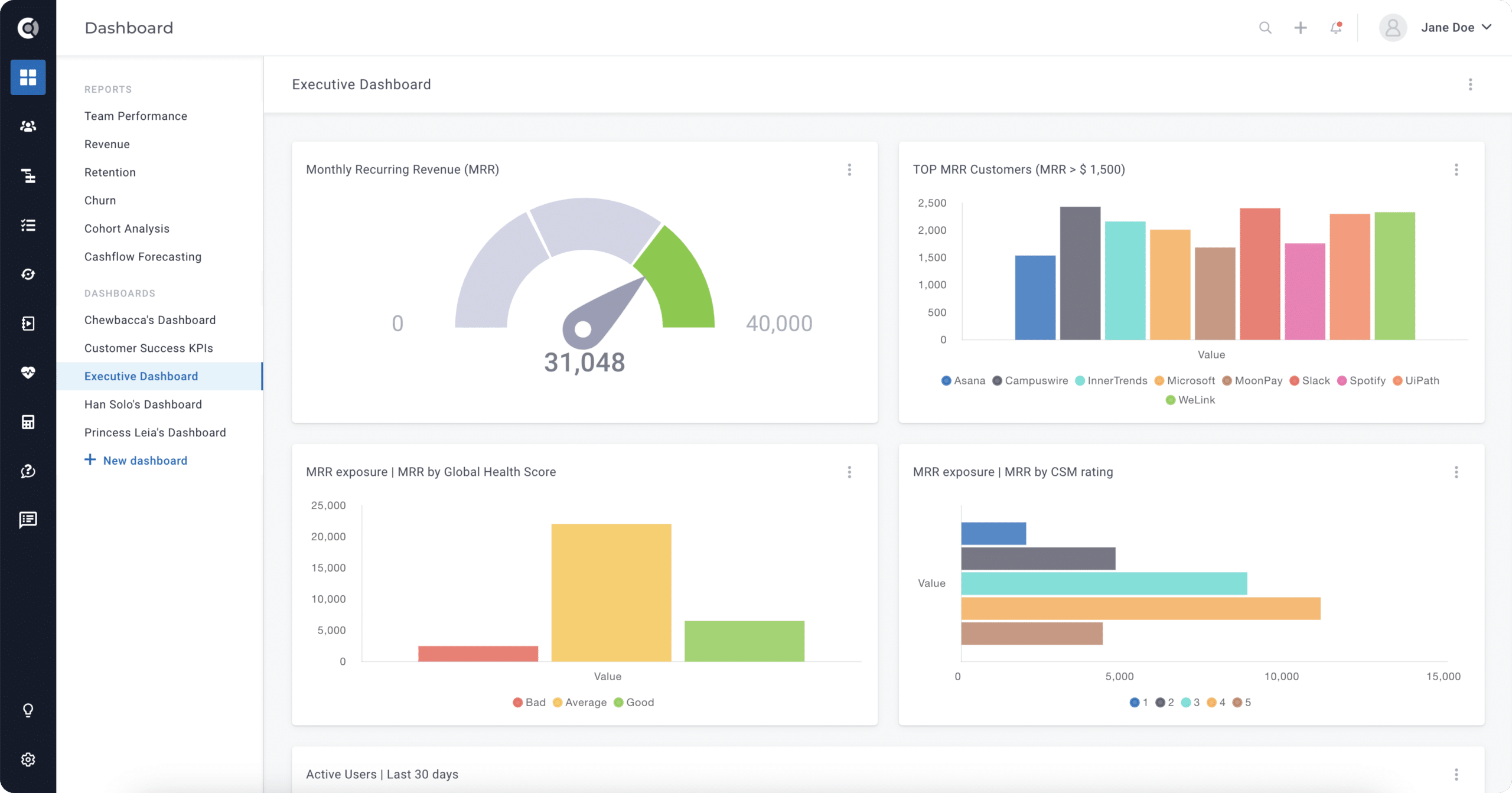
You can learn more about the differences between a CSS and a CRM here.
That being said, how you segment your customers inside your CSS depends on what’s right for your SaaS and what your customers want. Sometimes, that may even have you combine more than one factor when creating segments.
Now, let’s look at some of the most often-used SaaS segments.
1. New adopters vs. power users
First impressions matter. It’s why you simply cannot afford not to wow your users right from the very first contact they have with your service. If you confuse them or don’t offer enough value right from the get-go, these users will likely not stay with you for long.
As a result, you need to take your time and assemble an onboarding flow that makes users immediately understand how much they stand to gain from using your product. This flow should both educate (show users how to make the most of your service) and reveal value (show users how their lives will change for the better).
Now, what about power users? First, it’s important to highlight that power users are not those who use your product most often. They’re also not your oldest or most active users. Nor are they those who use your product in the best possible way.
So then, who are these elusive power users? They are your best users. When we say best, we refer to those users who drive your Average Customer Value numbers up, your Customer Acquisition Costs down, and those who help you identify product use cases that would have never crossed your mind.
2. Trial users vs. paid subscribers
Riddle me this, riddle me that: If every SaaS out there wants to convert as many of their free trial users as possible, why do so many companies fail to fully implement free trial segmentation?
Most SaaS businesses treat their trials the same, even though their actions, behaviors, and intentions are not.
Imagine your free trial journey as a grand gala and each user as a distinguished guest. Segmentation is your method of assigning partners to the perfect dance. All free trials receive a ‘how to get started’ email. You can create segments that reflect their engagement levels based on their actions within that email. Users who open the email and actively navigate through onboarding actions are tagged as highly engaged. These guests deserve the VIP treatment – a customer journey overflowing with relevant and nurturing communications.
For those who don’t engage, the music doesn’t stop; it just changes tune. A follow-up email can extend a hand, offering guidance on specific features they might seek.
Suppose you’ve converted most of your free trials to paid subscribers. As a result, they now appear in a whole different segment. Where do you go from here?
Once again, we suggest further segmenting paid users and creating personalized campaigns for each micro-segment. For instance, you don’t want to bug users who bought your most expensive plan with emails that prompt them to upgrade. Those emails may be better suited for those users with low MRR.
3. Active vs. inactive
Active users are the lifeblood of any SaaS platform. They are the individuals who regularly engage with your product or service, utilizing its features and reaping its benefits. These users are the foundation of a healthy customer base, representing a promising source of recurring revenue and growth potential.
On the flip side, inactive users are a big problem for any SaaS. These are customers who have, for various reasons, stopped using your product or engaging with your platform and who are most likely to churn. If you’re to stand any chance of getting them to engage with your product again, you’d better know what made them stop using it.
Once you’ve identified the issue, don’t even think about contacting them with in-app messages. That ship sailed the moment they stopped using your service. Emails are the way to go. Or, for users with potential, a phone call may be an even better option.
Now, how do you go on about your active users? Once again, it’s important to dig a little big deeper here. A platform like Custify can group active users based on their usage patterns. Use these patterns to tailor your content and create personalized experiences.
Try to nurture a sense of community through webinars and user groups. Consider giving them a platform where they can share insights and network. By providing ongoing value and fostering meaningful interactions, you can transform active users into power users, solidifying a relationship that extends far beyond transactions.
4. Freemium users
If your SaaS is based on the Freemium model, you’ll have a lot of lifetime free users. While that’s great for spreading the word, converting them to paying customers would be even greater. But how do you do that?
First and foremost, it’s important to get the users to use your product. After all, how else are they going to recognize your value? Once again, a well-designed onboarding email sequence is essential. However, as opposed to the onboarding of your new customers, this one should be a little different. Different how – you probably wonder. One way to make it stand out would be to tease those premium features and functionalities and showcase their true worth.
Whether you choose to entice your freemium users via email or directly within your platform, the essence lies in showcasing the enhanced benefits that await, gradually nurturing their transition to becoming paid members.
5. Renewal timelines
A successful renewal strategy is all about sending the right message at the right time to the right people.
When it comes to renewals, you want to take a proactive approach and entice users to renew (ideally) before their expiration date. The goal is to get the client to renew his subscription as early as possible. Some strategies you can rely on to nudge your users in this direction are:
- Value Recap Emails: Periodically send emails that highlight the ROI they’ve gained from your service. Make it data-driven to show real value.
- Early Bird Offers: Offer a discount or an extra feature for early renewals. Make it a no-brainer to renew ahead of time.
- Customer Success Check-ins: A quick, personalized check-in from your team can go a long way. Use it to address any concerns and hint at the benefits of renewal.
- Automated Reminders: Use your SaaS platform to send automated renewal reminders. Make it a one-click process to renew.
- Feature Teasers: Briefly mention upcoming features that they’ll benefit from if they renew. Make the future look exciting.
Now, let’s take a look at how some of your messages may look depending on where your customers find themselves in their billing cycle.
Early in the billing cycle
At this stage, your focus should be on reminding customers about the benefits of your product and the value they receive. You might send personalized emails highlighting specific features or success stories from satisfied customers. To encourage early renewal, consider offering additional incentives, such as exclusive access to new features or special promo deals.
Midway through the billing cycle
As customers approach the halfway point, it’s a good time to check in and address any potential concerns or issues they may have. Provide helpful resources, such as tutorials or case studies, to ensure they get the most out of your product. You could also offer limited-time promotions or discounts to incentivize renewal.
Toward the end of the billing cycle
Your messaging should intensify in the final stretch before the subscription expiration date. Remind customers of the approaching renewal deadline, emphasizing the value they’ll continue to receive by staying subscribed. Highlight any recent product updates or enhancements that make renewal even more appealing.
Consider sending a series of well-timed reminders as the renewal date nears. These reminders can include countdown emails, ensuring customers know the limited time remaining to secure their subscription. Provide flexible renewal options, such as switching to a more suitable plan or customizing their subscription based on their evolving needs.
Furthermore, you can offer dedicated support channels for any questions or concerns customers may have about the renewal process. This ensures a smooth, hassle-free experience, reinforcing their trust and satisfaction with your service.
Expired subscribers
So, some users let their subscriptions lapse. Bummer, right? Wrong. These folks are a goldmine of insights and, believe it or not, potential revenue.
First off, let’s play detective. Why’d they walk away? Was it the price, or maybe they’re not using all the features? Shoot them a quick, non-intrusive exit survey (also known as customer offboarding). Trust me, the feedback’s gold.
Now, onto the fun part—winning them back. Craft a killer win-back campaign tailored to address their specific pain points. Maybe offer a “We Miss You” discount or a sneak peek into new features they’ll love. Add a dash of urgency with a limited-time offer and sprinkle in some customer success stories for that extra push. Remember, it’s way cheaper to win back an old customer than to find a new one.
Low NPS-score users
With a tool like Custify, you can say goodbye to the days of manually sifting through NPS data in Excel. We automate the whole shebang, serving up real-time segmented data on a silver platter. Now, let’s talk about those low promoter score users. They’re basically waving a red flag that screams “I might churn!” So, you better pay attention.
First things first, figure out why they’re unhappy. Is it a feature they’re missing, or maybe it’s a usability issue? Once you’ve got that intel, you can create targeted campaigns to address those specific issues. Think of it as a surgical strike to boost satisfaction.
Worried about sounding too creepy? Don’t be! According to Salesforce, 70% of consumers say that a company understanding how they use products and services is very important to winning their business.
But hold on, let’s zoom out a bit. How’s your overall NPS doing? If it’s under 4, you’ve got some soul-searching to do. It’s not just about patching up issues for a handful of users; it’s a sign you need to up your game across the board.
Final thoughts
They say it costs up to five times more to acquire a new customer than it does to keep existing ones. With that in mind, it’s no wonder that personalized experiences throughout the entire customer journey are becoming the new norm. How do you build those custom experiences? You start with segmenting your customers.
But here’s the twist: segmenting isn’t just about understanding your customers; it’s about showcasing that understanding through meaningful interactions. It’s like serenading them with their favorite song or whipping up their beloved dish – it’s all about delivering what they love most.
In a world where choices abound, customers crave relevance. They want to feel special. They don’t want to be just another small fish in a big sea. That’s where segmenting steps in as your magical wand, waving away the generic and conjuring up the spectacular.
We encourage you to request a demo to see Custify work its magic in customer segmentation.
